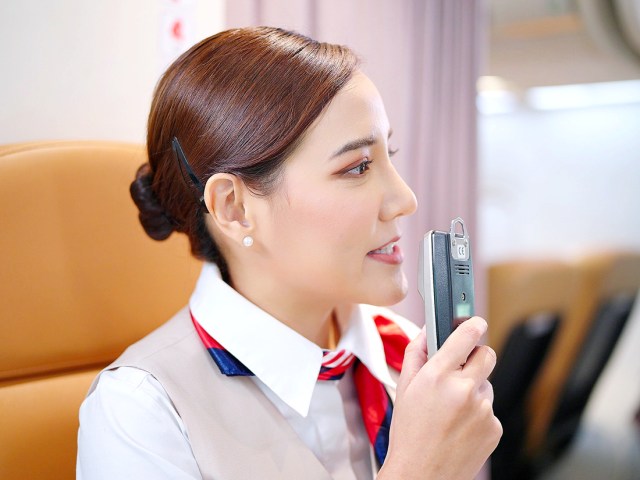Flight attendants aren’t just there to serve food and beverages — their comprehensive safety training and many hours of experience help to ensure that we all reach our destination safely. For the vast majority of flights, the journey passes without incident, but still, you may have noticed a few of the procedures and precautions that form part of their working routine — like when flight attendants sometimes sit on their hands during takeoff. Below, discover the reason why that happens and some of the other steps flight attendants take to keep passengers safe.
Why Do Flight Attendants Sit on Their Hands During Takeoff?

Flight attendants take their seats only after they’ve completed their final checks on passengers and secured the cabin. They pull down a jump seat and buckle up — and then they often sit on their hands. It is part of the brace position, which also includes ensuring feet are placed flat on the floor and the head is positioned so that it remains as steady as possible. These actions are designed to ensure that, in the event of an emergency, a flight attendant’s body would remain relatively rigid. (While this type of brace position is used at many airlines, other airlines have different procedures, such as placing hands on knees or crossing and folding the arms over the chest.)
This also means, should turbulence occur, there’s much less likelihood of the kind of injury that could be caused if their arm was suddenly flung into a bulkhead or seat. It’s good practice, as flight attendants need to be fully mobile to look after their passengers most effectively during an emergency.
The Cabin Crew Must Know Specific Details About Each Aircraft Type

There are myriad types of aircraft passengers fly on, and they are all configured differently inside. So, it’s vital that flight attendants know each different cabin inside and out. (For the same reason, passengers should also read the safety card even if they fly frequently.)
As well as undergoing extensive training, members of the cabin crew meet onboard as a team well before passengers join them for a briefing. This covers any points of note about the aircraft itself, such as the location of emergency exits (and how they open) as well as the seating configuration. The lead flight attendant or cabin manager will also pass on other relevant information, such as the expected weather during the flight which could potentially influence the amount of turbulence.
Pre-Flight Checks of Emergency Equipment Are Also Carried Out

While the pilots are going through their pre-flight checks in the cockpit, each member of the cabin crew is tasked with their own checklist. This happens before every flight and includes completing an inventory of the emergency equipment on board to make sure it is stowed correctly, hasn’t been tampered with, and is in full working order. Some of this gear forms part of the aircraft itself — such as emergency exit signs and smoke detectors — while other equipment is portable.
Flight attendants will also test the public address system to make sure that it is operational and take a look through the plane to confirm items such as fire extinguishers, first-aid kits, defibrillators, and oxygen cylinders are located where they should be. It’s an important safety step, because if such equipment was needed during the flight, wasting even a small amount of time could have serious consequences.
More Checks as Flight Attendants Welcome Passengers on Board

Even as members of the cabin crew welcome passengers on board, they perform other silent checks designed to keep us safe. Each flight attendant has been trained to look out for tiny details that might seem a little off. For example, are any passengers behaving in an unusual manner, or carrying hand luggage that looks suspicious? In addition, they will be looking at body language. Is someone noticeably scared to be on board? A nervous flier might need a little extra reassurance during takeoff, landing, or times when the flight might get a little bumpy.
Even more importantly, flight attendants will scrutinize passengers’ behaviors to figure out if anyone trying to board has overdone it at the airport bar, as this could make them aggressive or unpredictable during the flight. Because of the implications for safety of all those on board, any passenger disturbances associated with alcohol during a flight are considered serious and must be reported to the FAA, but allowing an intoxicated person on the plane in the first place is also an offense. For flight attendants, it’s all part of the job to ensure each flight safely reaches its final destination.
More from our network
Daily Passport is part of Inbox Studio, which publishes content that uplifts, informs, and inspires.
















